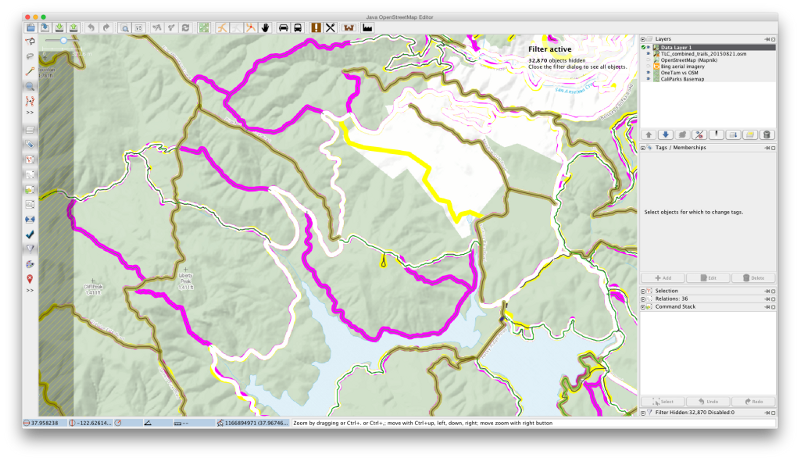A how to guide (in the weeds, so to speak)

Update on Tagging
added March 25, 2016
The coverage of our efforts to mark prohibited trails prompted a fair amount of conversation on OpenStreetMap’s mailing lists (this message and following) and chat rooms. Based on community discussion there and elsewhere, the best solution for marking social trails is to mark them as “access=no” (here’s an example). This preserves the original tag of for the “highway” value (usually “path” for trails). This is a reasonable solution as well, though it does mean that mapmakers need to opt out by excluding “access=no”, rather than opt in to showing “social_path.” Both solutions are reasonable though differ in emphasis, and we’re happy that the issues of unauthorized trails is being discussed so fruitfully. We have put in a formal proposal for social_path and plan to continue helping find solutions for open space agencies to work with OpenStreetMap with the shared goal of making the most complete and accurate maps possible.
Original post follows:
In a previous post, I described how Stamen carried out a first foray into trail curation on OpenStreetMap to deal with unauthorized trails appearing on the custom base map we design for CaliParks.org, the app we developed as a guide to 11,826 parks and open spaces in California.
Rather than deleting these “social trails,” which were damaging parks, we changed their tags so that they’re easily filtered out of the map but still present, so later mappers understand why those paths, which might be visible in satellite imagery and on the ground, aren’t showing up on their favorite OSM-based map.
OK, so far so good. But how many trails did we find and change? And how did we find them?
Building on work we did with Trailhead Labs for the Department of Interior’s Dev4Outdoors hackathon (more on that here), we created a functional if not so pretty layered map to highlight the differences between OpenStreetMap data and official data from OneTam, the consortium of agencies that manage these public lands.
We found 19 trail segments in OSM that did not appear in the official data and that appeared to be unauthorized trails, which are sometimes called “social trails.” We tagged them as such, and you can see the edits in these viewers:
- http://nrenner.github.io/achavi/?changeset=34599982
- http://nrenner.github.io/achavi/?changeset=33656715
- http://nrenner.github.io/achavi/?changeset=33655914
- http://nrenner.github.io/achavi/?changeset=33655830
It’s important to note that we didn’t delete these trails. Instead we tagged them as “social_path”, which allows us to filter them out of our maps, and also allows anyone else to remove them from display, while leaving them in the source data. That’s important so that future volunteer mappers know why trails that they see on the ground or in satellite imagery are not showing on public-facing maps derived from OSM data. (*See top of this post for an update on methods.)
The idea is to acknowledge that the paths exist, but flag them so that it’s clear that they are not authorized and should not be used. Also, in some cases, we split a trail up to show that one part is authorized and the other is not.
Comparing Data
The method we used to create the “visual diff” of official vs. OSM trails is rather involved and relies on CartoDB.com, Stamen’s Sandwich Maker utility, and a desktop OSM editor called JOSM. Not for the faint of heart and best set up when you need to survey a large area, since you can see differences and make edits right in the same window.
But any time you see an errant trail on an OSM-derived map, such as the one we use on CaliParks.org, you can head over to openstreetmap.org, create an account, log in, and edit the trail right in your browser. And you can do some pretty good comparing in your browser over at TrailEditor.org’s fusion view.
Note that we also added one trail (the Music Stand Trail) that was missing from OSM, which is great. Now the map is more complete. What we didn’t do was try to judge whether actual trail routes were located more precisely on OSM versus the official data. There are some potentially promising ways to do that, including using Strava’s heatmaps to see where people are actually walking and biking. But that’s a task for another day.
Dan Rademacher is executive director of GreenInfo Network. He worked on CaliParks.org as a project director at Stamen Design.
